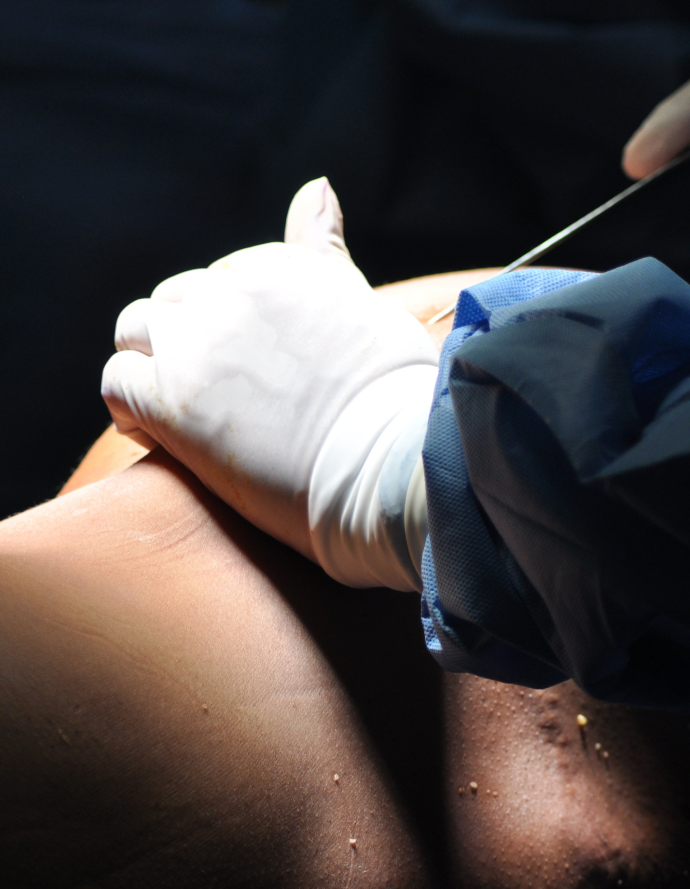VASER Liposuction
VASER Liposuction in Singapore
Contour your body and achieve muscle definition with the VASER Hi-Def Lipo, which targets specific areas of the body with improved gentleness and precision. Many people deal with stubborn fat that does not seem to respond to any amount of dieting and exercise. An alternative to the traditional invasive liposuction surgery, the VASER liposuction is a minimally-invasive technique that uses ultrasound energy to break down fat deposits before carefully removing the fat without harming surrounding tissues.
Medically Reviewed by Dr Colin Tham
Consultant Plastic & Reconstructive Surgeon
MB ChB (Aberdeen), FRCS (Ireland), FAMS

What is Liposuction?
Liposuction is a popular cosmetic surgical procedure designed to remove excess fat deposits from specific areas of the body, enhancing overall body contours and proportions. It is not a weight-loss solution but a body-sculpting technique that targets stubborn fat pockets resistant to diet and exercise. Traditional liposuction involves suctioning out fat through small incisions using a hollow tube called a cannula.
The procedure is commonly used to improve the silhouette and can be performed on various body parts, including the abdomen, thighs, hips, arms, back, and neck. While it does not address cellulite or skin laxity, liposuction offers significant aesthetic improvement and is often combined with other procedures for optimal results.
What is Vaser Liposuction?
Vaser liposuction is a more advanced form of liposuction that uses ultrasound technology to selectively break down fat cells before removing them. "Vaser" stands for Vibration Amplification of Sound Energy at Resonance. This technique liquefies fat using ultrasonic energy, making it easier to remove while preserving surrounding tissues such as nerves, blood vessels, and connective tissue.
Vaser liposuction is known for its precision and ability to sculpt and define the body with greater accuracy. It is particularly beneficial for patients seeking high-definition results or those who want fat removed from more delicate areas. Because it is less traumatic to the body than traditional liposuction, Vaser liposuction typically results in reduced bruising, swelling, and a quicker recovery.
Why Choose Us for VASER Liposuction in Singapore?
- Dr Colin Tham was one of two pioneer plastic surgeons personally trained by the inventor of the VASER HiDefinition technique, Dr Alfredo Hoyos
- Dr Colin Tham is recognized for introducing the HiDef VASER technique to Singapore in 2007
- All procedures are conducted in an MOH-accredited surgical facility
- Over two decades of experience and strong track record in VASER liposuction
Who is a Good Candidate for VASER Liposuction?
Ideal candidates for traditional liposuction or Vaser liposuction are individuals who are in good general health but struggle with localized fat deposits that do not respond to diet or exercise. Candidates should have a stable body weight, good skin elasticity, and realistic expectations about the outcomes.
Liposuction is not intended for overall weight loss or as a treatment for obesity. Instead, it is best suited for refining body shape and improving proportions. People with firm, elastic skin tend to achieve the most satisfying results, as the skin can better conform to the body's new contours.
Candidates should also be non-smokers or willing to quit smoking before and after the procedure to promote proper healing. During a consultation, a plastic surgeon will evaluate your goals, medical history, and physical condition to determine if liposuction or Vaser liposuction is the right solution for you.

What Areas Can Be Treated by VASER Liposuction?
Traditional liposuction and VASER liposuction can target almost any area of the body where excess fat accumulates. Common treatment areas include:
- Abdomen and flanks (love handles)
- Thighs (inner and outer)
- Hips and buttocks
- Upper arms
- Back (including bra roll)
- Chest (especially for male gynecomastia)
- Neck and chin (double chin)
- Knees and calves
However, VASER liposuction is particularly effective in more fibrous or delicate areas, such as the male chest, arms, and inner thighs, and is often chosen for high-definition body sculpting around the abdominal muscles.
How is VASER Liposuction Performed?
VASER liposuction begins with the administration of tumescent fluid, which is a sterile solution containing saline, local anaesthetic, and epinephrine to numb the area, reduce bleeding, and prepare fat for removal. Once the area is adequately anaesthetized, a small probe is inserted through tiny incisions to deliver ultrasound energy to the fat tissue.
The ultrasonic waves selectively break down the fat cells, emulsifying them into a liquid form without significantly affecting surrounding tissues. This process allows for easier and more precise fat removal using a suction cannula. Because the technique is gentler, it causes less trauma to the body and leads to smoother contouring with minimal bleeding and swelling.
Vaser liposuction is often performed as an outpatient procedure under local anesthesia with sedation or general anesthesia, depending on the extent of treatment and the patient's comfort level.
How is Traditional Liposuction Performed?
Traditional liposuction also begins with the injection of tumescent fluid into the treatment area to reduce discomfort and minimise blood loss. Once the area is prepared, the surgeon makes small incisions and inserts a cannula, which is moved back and forth to mechanically break up and dislodge fat cells. The fat is then suctioned out through a vacuum device attached to the cannula.
While effective, traditional liposuction can sometimes result in more tissue trauma, bruising, and longer recovery times. It is generally well-suited for larger-volume fat removal but may not provide the same level of definition or skin tightening as VASER liposuction.
Possible Risks and Complications of VASER Liposuction
Like all surgical procedures, traditional liposuction and VASER liposuction carry some risks. Although complications are rare when performed by an experienced plastic surgeon, it is important to understand potential side effects, which may include:
- Swelling, bruising, and temporary numbness
- Infection or bleeding
- Irregular contours or asymmetry
- Fluid accumulation (seroma)
- Skin rippling or dimpling
- Scarring or skin discoloration
- Reaction to anesthesia
With VASER liposuction, however, there is a lower risk of bruising and damage to surrounding tissues compared to traditional methods.
Recovering from VASER Liposuction
Recovering from VASER liposuction varies depending on the extent of fat removal, the treated areas, and the patient's individual healing process. Most patients can return to light activities within a few days and resume normal routines within one to two weeks. However, full recovery and final results can take several months as swelling gradually subsides.
Patients are typically required to wear a compression garment for several weeks post-surgery. This helps reduce swelling, supports healing tissues, and improves the final contour. Mild discomfort, soreness, and tightness are common in the initial recovery period and can be managed with prescribed medications.
Strenuous activities, heavy lifting, and vigorous exercise should be avoided for at least four to six weeks. During follow-up visits, your surgeon will monitor your progress and provide guidance tailored to your recovery. Adhering to all post-operative instructions is key to achieving the best results and minimising complications.
Frequently Asked Questions

Liposuction Doctor in Singapore
Dr Colin Tham
Consultant Plastic & Cosmetic Surgeon MB ChB (Aberdeen), FRCS (Ireland), FAMS
Dr Colin Tham is an experienced plastic surgeon skilled in performing double eyelid surgeries. He is accredited by the Ministry of Health in Singapore and has over 20 years of experience in the field. Dr Tham received extensive plastic surgery training in Scotland, Taiwan, and Singapore; and is committed to providing beautiful and natural-looking outcomes for all his patients.
